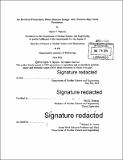An inverted pressurized water reactor design with twisted-tape swirl promoters
Author(s)
Nguyen, Nghia T. (Nghia Tat)
DownloadFull printable version (13.82Mb)
Other Contributors
Massachusetts Institute of Technology. Department of Nuclear Science and Engineering.
Advisor
Neil E. Todreas.
Terms of use
Metadata
Show full item recordAbstract
An Inverted Fuel Pressurized Water Reactor (IPWR) concept was previously investigated and developed by Paolo Ferroni at MIT with the effort to improve the power density and capacity of current PWRs by modifying the core geometry. A detailed study was performed to optimize the IPWR design considering mechanics, thermal hydraulics and neutronics design constraints from which it was concluded that the maximum achievable power for the IPWR design was 4078MW, 19 percent higher than the reference PWR (the Seabrook Power Station), limited simultaneously by the core pressure drop and steady state departure from nucleate boiling (DNB) constraints. While the thermal power is already higher than that of typical pressurized water reactors (PWRs), it is still possible to achieve higher power by improving the DNB performance of the design. Unlike the conventional pin geometry in current PWRs, the inverted geometry opens the possibility to improve the core DNB performance by using swirl flow promoters. This thesis further takes advantage of the new core geometry to increase the core power density by using twisted tapes (TTs) as swirl flow promoters inside the IPWR cooling channels. The study focuses on optimizing the cooling channel design with twisted tapes to improve the DNB performance alongside using more powerful reactor coolant pumps to deliver higher core pressure drop limit. Four steady state design constraints, which are core pressure drop, DNB, peak fuel temperature and peak cladding temperature, are considered. As the core power rating is gradually increased from the reference value (3411 MWt), the steady state operating parameters can be calculated using Ferroni's IPWR analyzing tool and Arment's pressure drop and DNB correlations. The maximum achievable core power is determined when one of the design constraint reaches its limit value. Various options of IPWR cooling channel design, including the no TT (E-IPWR), full length TT (F-IPWR) and short length TT at a fixed location in the cooling channels (SF-IPWR), were investigated at different core inlet and outlet temperature conditions. Results show that the SFIPWR design offers the best performance in all cases. When using Ferroni's selected assembly geometry and operating with the AP1000 enthalpy condition, the SF-IPWR design can achieve the maximum core power of 4786 MWt, 140 percent of the reference core power, limited by the peak fuel temperature design constraint. By modifying the assembly geometry, higher power rating is achievable although more safety analyses would be needed to confirm the feasibility of operating at power rating higher than the reference plant full power value.
Description
Thesis: S.B., Massachusetts Institute of Technology, Department of Nuclear Science and Engineering, 2014. Cataloged from PDF version of thesis. Includes bibliographical references (pages 167-169).
Date issued
2014Department
Massachusetts Institute of Technology. Department of Nuclear Science and EngineeringPublisher
Massachusetts Institute of Technology
Keywords
Nuclear Science and Engineering.